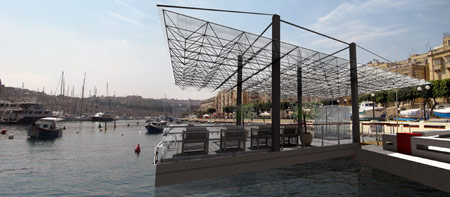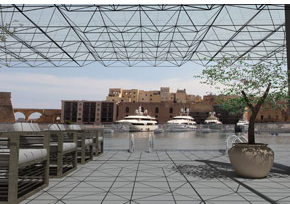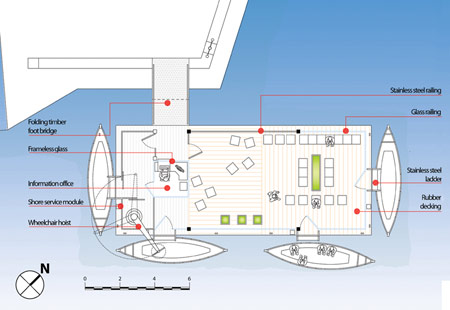Grand Harbour Network Initiative
Date : 2011The core of the project was the sustainable conservation of maritime heritage within the Grand Harbour region, in particular the traditional Dghajsa tal-Pass. Several tangible and intangible aspects were identified with respect to this tradition, and five urban and architectural interventions were proposed to address them.

The three tangible aspects identified were; Fabric, Activity and Memory. Fabric conservation deals primarily with the restoration and maintenance of the actual material that the boats are constructed from. Unfortunately a significant number of these boats, some dating back to the early 20th century, are in dire need of maintenance while others are damaged beyond repair. Timber tablet-sculptures depicting saints and patrons are common on these boats, which are worth restoring for their own merit. The conservation of an activity refers to measures taken to revive the Dghajsa tal-Pass as a mode of transport which, albeit still popular with tourists, has drastically lost popularity amongst locals. Apart from the cultural-heritage connotations of such measure, it also carries logistic and environmental benefits, especially in a region where vehicular traffic is heavy during peak hours. The conservation of memory, relating to the Dghajsa with respect to port activity, stems from the cultural significance of the Dghajsa tal-Pass, both in terms of aesthetics and historic integrity.

Intangible aspects were also identified, namely; Skill, Trade and Identity. The boat-building skill used to be available through a number of craftsmen, often inherited from one generation to another. However, with the decline of demand for the Dghajsa tal-Pass, craftsmanship has rapidly declined, and youths from the region seek employment elsewhere. This skill is also threatened by the demand for fiberglass replicas or high-speed contemporary water taxis. The trade of the Barklor, as a way of life, has the same fate as the boat-builders as witnessed by the fact that youths are a minority amongst those having the skills of steering, maintaining and daily operation of the Dghajjes tal-Pass within the Grand Harbour region. However, the Dghajsa tal-Pass still provides a strong sense of identity to the locals of the Three Cities, as evident during the Regatta which is held annually on the 8th of September in commemoration of Victory Day, a national day commemorating the victory of the Maltese over the Ottoman Empire.
In order to conserve such tangible and intangible heritage, a polycentric approach was adopted towards urban design to ensure that the project will be socio-economically feasible. Such an approach led to the utilization of existing infrastructural networks, while ensuring better sea-to-land intra-connections within the Grand Harbour. Five sites were indentified to initiate such incentive. These sites would house a sea-terminus, a landing place, an interactive heritage experience centre, a restoration and maintenance workshop and administrative offices. The sea-terminus, located at Sengla, was designed on the proportions of the Dghajsa tal-Pass, and is essentially a floating pontoon roofed over by glass supported by a stainless steel space-frame. The transparent and reversible design is sensitive towards the existing historic setting and does not hinder panoramas of the Grand Harbour.

A landing place, which also serves as a prototype for future expansion of the incentive, was designed on similar grounds to the sea-terminal; however it has a smaller footprint. Given that several infrastructural projects are proposed within the Grand Harbour region, the floating nature of the landing place facilitates its temporary removal or relocation. Adaptability and reversibility are the two key factors that underline the design philosophy of this project.
